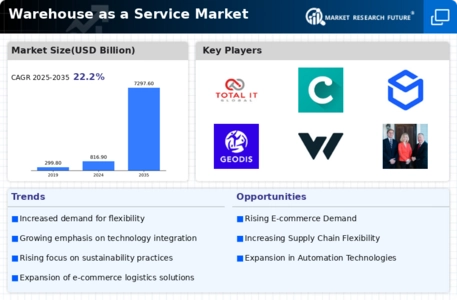Market Trends
Key Emerging Trends in the Warehouse as a Service WaaS Market
The warehousing industry is undergoing a transformative shift driven by the exponential growth of online sales, marking a significant catalyst for the expansion of the Warehouse as a Service (WaaS) market. The changing landscape of consumer behavior, with a preference for online shopping over traditional brick-and-mortar stores, has resulted in an unprecedented surge in online orders. This shift has created a pressing need for businesses to manage and fulfill these orders efficiently. In response to this demand, Warehouse as a Service (WaaS) providers have emerged as a crucial solution, offering scalable and flexible warehousing services designed specifically for e-commerce operations.
The impact of e-commerce growth is evident in the numbers. According to Morgan Stanley, global e-commerce has witnessed substantial growth, with its share of total retail sales increasing from 15% in 2019 to 21% in 2021, and it is currently estimated to be around 22% of total sales. This underscores the profound change in consumer behavior, emphasizing the growing significance of e-commerce in the retail industry.
Forecasts from industry experts further emphasize the continuous rise of e-commerce. Predictions from OBERLO indicate that global e-commerce sales are expected to reach $6.3 trillion in 2023, reflecting a 10.4% increase from the previous year. Additionally, projections from TIDIO suggest that global e-commerce sales will likely surpass $7 trillion in value by 2024. Factors contributing to this growth include the surge in mobile shopping, the increasing influence of social media, and the rising popularity of subscription services.
The proliferation of online sales is also evident in the increasing number of e-commerce websites. TIDIO reports that the global online retail market is home to between 12 and 24 million online retailers, showcasing a dynamic landscape with a continuous influx of new businesses. Notably, many of these online stores leverage popular platforms like WooCommerce or Shopify, indicating a growing inclination among consumers to make significant purchases online.
Market research conducted by MRFR aligns with these trends, projecting that the e-commerce market is poised for remarkable growth in the coming years, with global e-commerce sales expected to double by the end of the decade. This highlights the robust expansion of the online retail industry and the promising prospects it offers for businesses globally, thereby increasing the demand for Warehouse as a Service (WaaS).
Furthermore, the competitive landscape of the WaaS market is becoming increasingly fragmented, with intense competition anticipated in the years ahead. Key players in the market are implementing various strategies to maintain their presence in the e-commerce sector. For instance, Amazon's acquisition of health care provider One Medical and Walmart-owned Flipkart's stake acquisition in online pharmacy start-up Pharmallana showcase the strategic moves made by major players to bolster their positions. Collaborations and expansions, such as Amazon's cooperation with Tegut and Walmart's investment in a new Distribution Center in Mexico, further underscore the dynamic nature of the market and its alignment with the burgeoning online sales trend.
The rapid growth of online sales, driven by changing consumer preferences and advancements in e-commerce, has become a pivotal force behind the expanding Warehouse as a Service (WaaS) market. The increasing demand for efficient and scalable warehousing solutions, particularly tailored for e-commerce operations, underscores the transformative role of WaaS in meeting the evolving needs of businesses worldwide. The ongoing developments in the industry, coupled with strategic initiatives by key players, highlight the resilience and dynamism of the WaaS market in the context of the surging demand for online sales.





















Leave a Comment